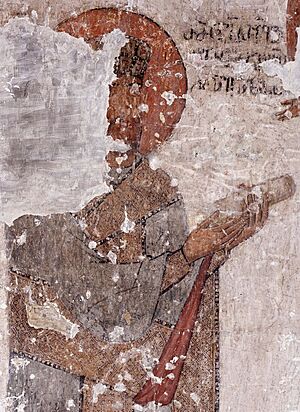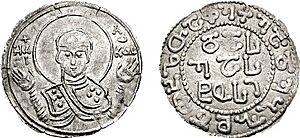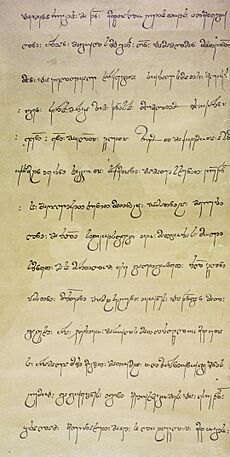Bagrat IV of Georgia facts for kids
Quick facts for kids Bagrat IV |
|
|---|---|

Fresco of Bagrat IV from Ateni Sioni
|
|
| King of Georgia (more...) | |
| Reign | 16 August 1027 – 24 November 1072 |
| Predecessor | George I |
| Successor | George II |
| Regent | Mariam of Vaspurakan |
| Born | 1018 |
| Died | 24 November 1072 (aged 53–54) |
| Burial | Chkondidi Monastery |
| Spouse | Helena Argyre Borena of Alania |
| Issue | George II of Georgia Maria of Alania Mariam |
| Dynasty | Bagrationi |
| Father | George I of Georgia |
| Mother | Mariam of Vaspurakan |
| Religion | Georgian Orthodox Church |
| Khelrtva |  |
Bagrat IV (Georgian: ბაგრატ IV; 1018–24 November 1072) was a king of Georgia. He belonged to the Bagrationi dynasty. Bagrat ruled the Kingdom of Georgia from 1027 to 1072. During his long time as king, Bagrat worked to gain more control over powerful nobles. He also wanted to keep Georgia independent from the Byzantine and Seljuk Empires.
Bagrat fought many battles. He managed to defeat his strongest rivals, especially the Liparitid family. He brought several smaller kingdoms under his control. He also made the kings of Lori and Kakheti-Hereti, and the emir of Tbilisi, follow his rules. Like many rulers in the Caucasus region during the Middle Ages, he held special titles from the Byzantine Empire, such as Nobilissimus, Kouropalates, and sebastos.
Early Years as King
Bagrat was the son of King George I of Georgia (who ruled from 1014 to 1027) and his first wife, Mariam of Vaspurakan. When Bagrat was just three years old, his father gave him as a hostage to the Byzantine emperor Basil II. This was part of a peace deal after George I lost a war against the Byzantines in 1022. Young Bagrat spent the next three years in Constantinople, the capital of the Byzantine Empire. He was released in 1025. He was still in Byzantine lands when Basil II died and his brother Constantine VIII became emperor. Constantine ordered Bagrat to be brought back, but the messenger couldn't catch him. Bagrat was already back in Georgia.
In 1027, King George I died. Bagrat, who was only eight years old, became the new king. His mother, Queen Mariam, became a very important helper, ruling for him. She shared this power with other powerful nobles, especially Liparit IV of Kldekari and Ivane, Duke of Kartli.
By the time Bagrat became king, the Bagrationi family was already working hard to unite all Georgian lands. The kings of Georgia ruled from Kutaisi in western Georgia. They controlled what used to be the Kingdom of Abkhazia and a large part of Iberia/Kartli. However, Tao had been lost to the Byzantines. A Muslim ruler still controlled Tbilisi, and the kings of Kakheti in eastern Georgia strongly defended their independence. Also, many powerful nobles in Georgia weren't always loyal to the king. While Bagrat was young, these nobles gained more power. Later, when he was older, he tried to reduce their influence.
At the same time, the Georgian kingdom faced two big enemies: the Byzantine Empire and the rising Seljuk Turks. Even though Georgia and the Byzantine Empire had long cultural and religious ties, and the Seljuks were a threat to both, the Byzantines sometimes acted aggressively in the Caucasus. This made Georgians not trust them and stopped these two Christian countries from working together well against the common threat. Bagrat wanted Georgia to be the strongest power in the Caucasus. So, his plan was to use the Seljuks and Byzantines against each other.
Battles for Control
Soon after Bagrat became king, Emperor Constantine VIII sent an army to take the important city-fortress of Artanuji (now Ardanuç, Turkey). He wanted to give it to a Georgian prince named Demetrius of Klarjeti. Demetrius's family had lost this land to Bagrat IV's grandfather, Bagrat III, years before. Some Georgian nobles joined the Byzantines, but Bagrat's loyal subjects fought bravely.
Constantine's death in 1028 stopped the Byzantine invasion. In 1030, Queen Mariam visited the new emperor Romanos III. She made a peace treaty. In 1032, she returned with a high Byzantine title for her son, curopalates. Mariam also brought a Byzantine princess, Helena Argyre, to be Bagrat's wife. Helena was the daughter of Basil Argyros, who was Emperor Romanos's brother. This marriage was a way to create a strong alliance between the two empires. However, Helena died soon after in Kutaisi. This gave the Georgian court a chance to make another alliance. Bagrat then married Borena, the daughter of the king of Alania, a Christian country in the North Caucasus.
In 1033, the royal family faced another problem. This time it was with Bagrat's half-brother Demetrius. Demetrius was the son of George I from his second marriage to Alda of Alania. Demetrius and Alda lived in Anakopia, a fortress in Abkhazia, which King George I had given them. Some powerful nobles tried to use Demetrius to oppose Bagrat, but their plan failed. The Georgian court tried to get Demetrius to be loyal, but it didn't work. Demetrius's mother, Alda, feared Bagrat. She went over to the Byzantines and gave Anakopia to Emperor Romanos III. The emperor gave her son Demetrius the title of magistros.
In 1039, Demetrius returned to Georgia with Byzantine soldiers. This time, he was supported by Liparit IV. Liparit was from the Liparitid family and was the most powerful noble in Georgia.
Liparit was the duke of Trialeti and later the commander of the royal armies. He had helped protect young King Bagrat in the early 1030s. Liparit showed his military skill again in 1034. He led a combined Georgian-Armenian army and defeated some enemy troops in Arran. In 1038, Liparit was close to capturing Tbilisi, the old Georgian capital. Tbilisi had been a Muslim stronghold since the 8th century. But the Georgian nobles were worried about Liparit's growing power. They convinced Bagrat to pull Liparit's army back, which stopped the plan. Because of this, Liparit became an enemy of the king. He started working with the Byzantines to get revenge on Bagrat and his nobles.
Liparit, fighting for Demetrius, had several victories against Bagrat. Even after Demetrius died in 1042, Liparit continued his fight. He allied with the Byzantines and David I of Lorri. After losing the Battle of Sasireti, Bagrat only controlled the western parts of his kingdom. During the Seljuk campaigns in Anatolia in 1048, Liparit was fighting with the Byzantines and was captured at the Battle of Kapetron. Bagrat used this chance to get back his eastern lands. However, the king's luck changed quickly when Liparit returned from being captured. The rebellious duke forced Bagrat to flee to Constantinople. Bagrat stayed there for three years (1050–1053) because of Liparit's tricks. While Bagrat was away, Liparit effectively ruled Georgia. He even made Bagrat's son George king and declared himself the regent. After Bagrat returned, Liparit fought him again. Finally, in 1060, Liparit's own followers turned against him and gave him to King Bagrat. Bagrat forced Liparit to become a monk. Now, Bagrat had the chance to limit the power of other princes. He made the kings of Lorri and Kakheti much less powerful. He also briefly controlled Tbilisi.
Seljuk Attacks
In the 1060s, Bagrat faced an even bigger problem. The Seljuks, led by Alp Arslan, began to attack the border regions of Georgia. Bagrat had to make peace by marrying his niece to Alp Arslan sometime after 1064. She later married the Seljuk Persian vizier Nizam al-Mulk.
The Seljuk threat made the Georgian and Byzantine governments want to work more closely together. To make this alliance stronger, Bagrat's daughter Mart’a (Maria) married the Byzantine co-emperor Michael VII Ducas between 1066 and 1071. It was very unusual for a Georgian princess to marry a Byzantine emperor. In Georgia, this was seen as a great diplomatic success for Bagrat.
On December 10, 1068, Alp Arslan, along with the kings of Lorri and Kakheti and the emir of Tbilisi, attacked Bagrat again. The regions of Kartli and Argveti were taken and looted. Bagrat's old rivals, the Shaddadids of Arran, were given the fortresses of Tbilisi and Rustavi as a reward. After Alp Arslan left Georgia, Bagrat got Kartli back in July 1068. Al-Fadl I b. Muhammad, from the Shaddadids, set up camp near Isani (a part of Tbilisi) and, with 33,000 men, destroyed the countryside. However, Bagrat defeated him and forced the Shaddadid troops to run away. On the road through Kakheti, Fadl was captured by the local ruler Aghsartan. Bagrat paid a price to free Fadl, giving up several fortresses on the Iori River. In return, Fadl gave Tbilisi to Bagrat, who then put a local emir in charge there, making him a vassal.
The last years of Bagrat's rule happened around the time of a very important event for Christian nations in the East. This was the Battle of Manzikert, where Alp Arslan strongly defeated the Byzantine army. He even captured the emperor Romanos IV, who was later removed from power and died sadly. Bagrat IV died the next year, on November 24, 1072. He was buried at the Chkondidi Monastery. His son, George II, became the new king of the troubled kingdom of Georgia.
See also
- Bagrat III of Klarjeti
- Gurandukht of Georgia




